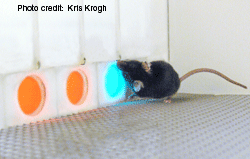The idea is that the lights can be a whole range of colors. To get the drop of soy milk, a mouse has to pick the light that is a different color from the other two. For example, to test the mouse’s color vision, the scientists could make two of the lights red and one green. Or vice versa. If the mouse is colorblind and couldn’t tell the colors apart, she’d get it right about a third of the time. And that’s what the scientists found for some of the mice.
But some of the mice that got the human gene picked the right light about 80% of the time. So these mice could probably tell red from green. This tells us that it takes a single gene to develop color vision. And that our color vision evolved relatively easily.
 One of the reasons I liked this story was actually the background information I needed to gather to understand it. You see, in school I never really learned about how color vision came about. And it is fascinating. The ability to tell red from green actually evolved independently in different primates. Old World primates like us gained the ability one way. New World primates developed it another way.
One of the reasons I liked this story was actually the background information I needed to gather to understand it. You see, in school I never really learned about how color vision came about. And it is fascinating. The ability to tell red from green actually evolved independently in different primates. Old World primates like us gained the ability one way. New World primates developed it another way.
The reason I needed to learn this is that the genetically engineered mice could tell red from green in the New World style. Which is pretty confusing.
Let’s look at the Old World style first. When we look at our DNA, we can tell that our third cone gene is really just a duplication of one of our other cone genes. Sometime in our distant past, an extra copy of the gene was accidentally made. This happens sometimes.
Over time, changes happened in the duplicated copy. Some of these changes created a new gene that let primates tell red from green. This is a common way for new genes to evolve.
But New World monkeys developed this talent in a different way. Instead of an extra gene, they developed an extra gene version. This is a subtle but important difference.
Remember, many of our genes can come in different versions. For example, there isn’t a separate gene for blue and brown eyes. There is one gene called OCA2 that comes in two versions, brown and blue.
Same thing with this form of color vision in New World monkeys. What happened here was that one copy of their cone gene got a mutation that let them distinguish more colors. So the only New World monkeys who can see color are the ones who have a copy of each gene version. Monkeys with two copies of one version or the other can’t see our full spectrum of colors.
Now to add one more wrinkle, these genes are on the X chromosome. Which means only New World female primates have a chance to tell red from green (poor design!).
This is because only females can have one copy of each gene version. Remember, in mammals males have an X and a Y chromosome and females have two X chromosomes. Which means males have only one copy of all the X chromosome genes while females have two.
For Old World primates, that means men and women can both tell red from green. There are two separate genes on the X chromosome. But for New World primates, only the females have this ability.
So in the mice experiments, the scientists created New World mice. Only the females had a chance to tell red from green. And only if they had a copy of each version of the gene. Scientists found that female mice with one copy of each version of the cone gene were no longer red-green colorblind. One new gene version was enough to give mice the ability to tell red from green.
It is so cool that the two primates developed color vision in different ways. Better color vision is a real asset for animals who forage during the day. So it isn’t surprising that once it arose, it spread quickly through the primate population.
And it is amazing how clunky the New World color vision is. Only females have the superior color vision. And many of her offspring will not have color vision. Thank goodness we evolved differently!
How colorblindness is inherited in people
http://www.thetech.org/genetics/ask.php?id=80
Journal article describing the mouse experiment
http://www.sciencemag.org/cgi/content/abstract/315/5819/1723
How dogs see color
http://www.puplife.com/dogcaretips/howdogsseecolors.html
 Dr. Barry Starr is a Geneticist-in-Residence at The Tech Museum of Innovation in San Jose, CA.
Dr. Barry Starr is a Geneticist-in-Residence at The Tech Museum of Innovation in San Jose, CA.
 Did you know most mammals are red-green colorblind? Part of what makes primates special is that most of us can tell the difference between red and green.
Did you know most mammals are red-green colorblind? Part of what makes primates special is that most of us can tell the difference between red and green.
